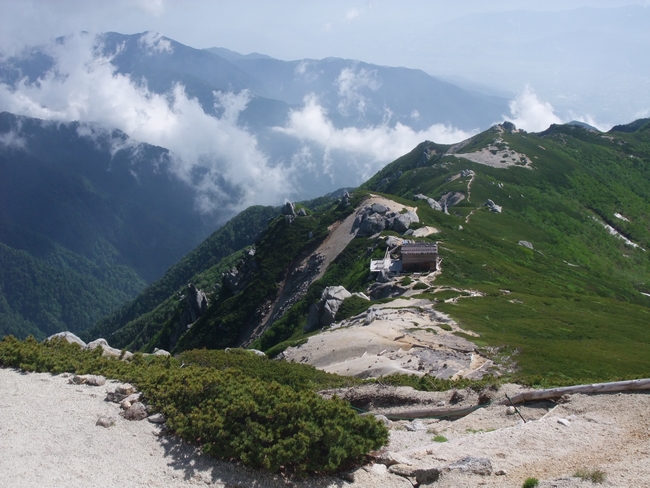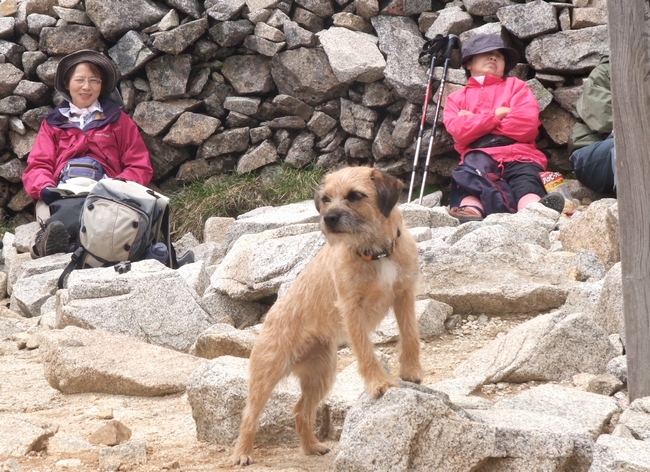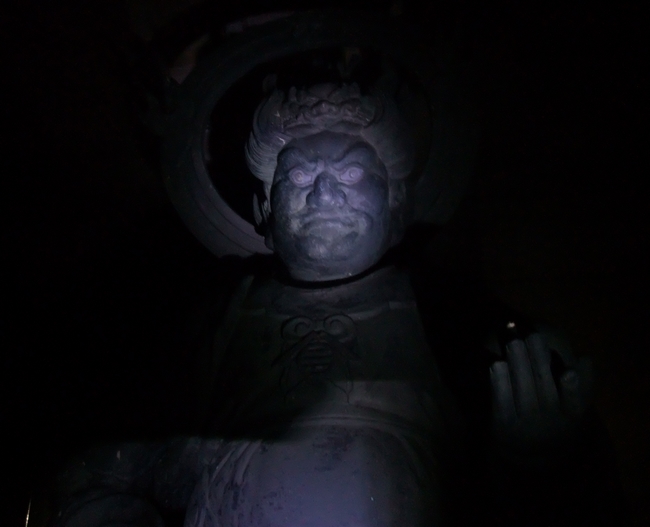
We both suffered this morning. Chokai on the map looked a breeze, but the maths did not tally. Asahidake was approximately 1300 meters of altitude gain, one-way distance of 8.2 km, map climb time of 6 hours. Chokai was a slightly smaller gain, the same distance, but a climb time of 4 hours, and it felt a hard slog. Perhaps we were simply tired.
The Shinzan peak was a heap of murderously sharp, large rocks, many of which had been defaced with name carvings. Mind-boggling to imagine guys (presumably) preparing mallet and chisel for such premeditated action.
The conventional way to descend a snowfield …

Keisuke showing the quicker way …

At the base of Gassan there was a sentrybox, the stuff of nightmares, manned by a crusty old man who scornfully looked at my running shoes, “You have got proper mountain boots, haven’t you?” Yes, I had. Still in the car. “You can’t get up without crampons. Impossible!”
He was trouble, so I packed Hana into her carrycase before taking her out of the car, covered the case with my wind jacket, and then dashed past the guard while he was hectoring another would-be climber. I kept her in the case for the short chair-lift ride, but at 2 pm, we were the only ones going up, passing a steady stream of satisfied hikers on the descending chairs. As we neared the top, the first spots of ominously heavy rain fell. Within 5 minutes of hiking, the heavens opened. Keisuke, with no particular agenda, wisely returned to the hut. The die-hard skiers rapidly cleared off the slope. All hikers were on their way down. Was I mad? And then thunder reverberated around the hill.
I stopped. This was nuts. Time to turn around. But after backtracking 50 meters, the ghost of Hakusan came back to haunt me. I had abandoned that one because of rain, and now faced a long trip back there sometime. Gassan was even further from Tokyo. Hana looked dismayed as I started back up the slope, my shoes now filled with rain and the path a running stream. Once you’re this wet, it no longer matters. A sweet-looking lady muttered “Kawaii so” as she passed. Yes, that’s how I felt, but she was looking at the dog. Another hiker suggested I be careful of the lightning. I replied that I hoped the gods would be kind. Once the decision was made, the madness of it made the climb enjoyable. And of course, almost no one was wearing crampons.

I raced through the entrance to the shrine at the top, past the hut and up the final few steps to the summit when a loud voice summoned me, “Come here!” I was surprised to see a priest, who in the politest of ways, informed me that I would have to pay 500 yen if I wished to go up those steps, and that dogs were not allowed within the precinct, for this was a holy place.
Normally, I might have argued back, but the Power of the Church was indeed mighty. “Stay!” kept the dog at the entrance, the priest blessed me for 500 yen with a wave of his white wand, and after paying my respects at the shrine, I asked the priest to keep the gods from striking me down with lightning on the descent. It was money well spent.
























